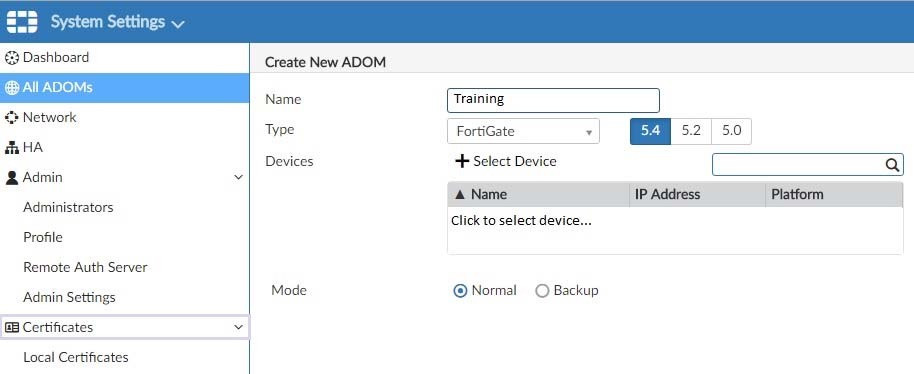Exam Details
Exam Code
:NSE5_FMG-5.4Exam Name
:Fortinet NSE 5 - FortiManager 5.4Certification
:Fortinet CertificationsVendor
:FortinetTotal Questions
:56 Q&AsLast Updated
:Aug 08, 2025
Fortinet Fortinet Certifications NSE5_FMG-5.4 Questions & Answers
-
Question 21:
View the following exhibit:

Which of the following statements are true regarding when ADOM is set as Normal mode on the FortiManager? (Choose two.)
A. Cannot assign the same ADOM to multiple administrators
B. Supports FortiManager script feature
C. FortiManager automatically installs the configuration difference in revisions on the managed FortiGate
D. Allows making configuration changes for managed devices on FortiManager panes
-
Question 22:
When installation is performed from the FortiManager, what is the recovery logic used between FortiManager and FortiGate for an FGFM tunnel?
A. After 15 minutes, FortiGate will unset all CLI commands that were part of the installation that caused the tunnel to go down.
B. FortiGate will reject the CLI commands that will cause the tunnel to go down.
C. FortiManager will revert and install a previous configuration revision on the managed FortiGate.
D. FortiManager will not push the CLI commands as a part of the installation that will cause the tunnel to go down.
-
Question 23:
Which of the following statements are true regarding VPN Manager? (Choose three.)
A. VPN Manager must be enabled on a per ADOM basis.
B. VPN Manager automatically adds newly-registered devices to a VPN community.
C. VPN Manager can install common IPsec VPN settings on multiple FortiGate devices at the same time.
D. Common IPsec settings need to be configured only once in a VPN Community for all managed gateways.
E. VPN Manager automatically creates all the necessary firewall policies for traffic to be tunneled by IPsec.
-
Question 24:
What is the purpose of the Policy Check feature on FortiManager?
A. To find and merge duplicate policies in the policy package.
B. To find and provide recommendation to combine multiple separate policy packages into one common policy package.
C. To find and delete disabled firewall policies in the policy package.
D. To find and provide recommendation for optimizing policies in a policy package.
-
Question 25:
Which of the following conditions trigger FortiManager to create a new revision history? (Choose two.)
A. When FortiManager installs device-level changes to a managed device.
B. When configuration revision is reverted to previous revision in the revision history.
C. When changes to device-level database is made on FortiManager.
D. When FortiManager is auto-updated with configuration changes made directly on a managed device.
-
Question 26:
Which of the following statements are true regarding an FGFM keepalive message? (Choose two.)
A. It includes the configuration checksum of FortiGate.
B. The keepalive interval for keepalive messages is configured on FortiGate.
C. It is sent only by FortiGate.
D. It is used between FortiManager HA cluster members to make sure cluster members are in sync.
-
Question 27:
An administrator would like to authorize a newly-installed AP using AP Manager. What steps does the administrator need to perform to authorize an AP?
A. Authorize the new AP using AP Manager and wait until the change is updated on the FortiAP. Changes to the AP's state do not require installation.
B. Changes to the AP's state must be performed directly on the managed FortiGate.
C. Authorize the new AP using AP Manager and install the policy package changes on the managed FortiGate.
D. Authorize the new AP using AP Manager and install the device level settings on the managed FortiGate.
-
Question 28:
An administrator has assigned a global policy package to custom ADOM1. What will happen if the administrator tries to create a new policy package in custom ADOM1?
A. When a new policy package is created, you need to reapply the global policy package to the ADOM.
B. When creating a new policy package, can select the option to assign the global policies to the new package.
C. When a new policy package is created, it automatically assigns the global policies to the new package.
D. When a new policy package is created, you must assign the global policy package from the global ADOM.
-
Question 29:
An administrator wants to delete an address object that is currently referenced in a firewall policy. Which one of the following statements is true?
A. FortiManager will replace the deleted address object with the all address object in the referenced firewall policy.
B. FortiManager will disable the status of the referenced firewall policy.
C. FortiManager will not allow the administrator to delete a referenced address object.
D. FortiManager will replace the deleted address object with the none address object in the referenced firewall policy.
-
Question 30:
What are the factory default settings on FortiManager? (Choose three.)
A. Password is fortinet
B. port1 interface IP address is 192.168.1.99/24
C. Service Access is enabled on port1
D. Username is admin
E. Reports and Event Monitor panes are enabled
Related Exams:
FCP_FAZ_AD-7.4
FCP - FortiAnalyzer 7.4 AdministratorFCP_FGT_AD-7.4
FCP - FortiGate 7.4 AdministratorFCP_FGT_AD-7.6
FortiGate 7.6 Administrator FCP_FGT_AD-7.6FCP_WCS_AD-7.4
FCP - AWS Cloud Security 7.4 AdministratorFCSS_EFW_AD-7.4
FCSS - Enterprise Firewall 7.4 AdministratorFCSS_NST_SE-7.4
FCSS - Network Security 7.4 Support EngineerFCSS_SASE_AD-24
FCSS - FortiSASE 24 AdministratorNSE4_FGT-5.6
Fortinet NSE 4 - FortiOS 5.6NSE4_FGT-6.0
Fortinet NSE 4 - FortiOS 6.0NSE4_FGT-6.4
Fortinet NSE 4 - FortiOS 6.4
Tips on How to Prepare for the Exams
Nowadays, the certification exams become more and more important and required by more and more enterprises when applying for a job. But how to prepare for the exam effectively? How to prepare for the exam in a short time with less efforts? How to get a ideal result and how to find the most reliable resources? Here on Vcedump.com, you will find all the answers. Vcedump.com provide not only Fortinet exam questions, answers and explanations but also complete assistance on your exam preparation and certification application. If you are confused on your NSE5_FMG-5.4 exam preparations and Fortinet certification application, do not hesitate to visit our Vcedump.com to find your solutions here.